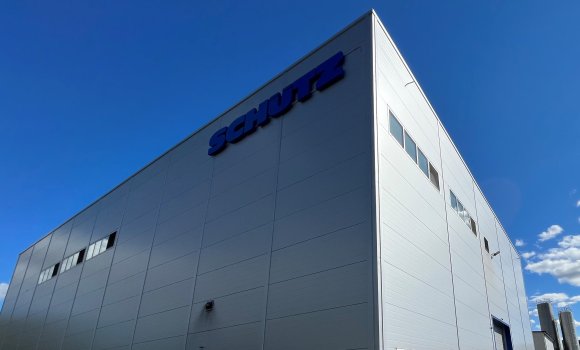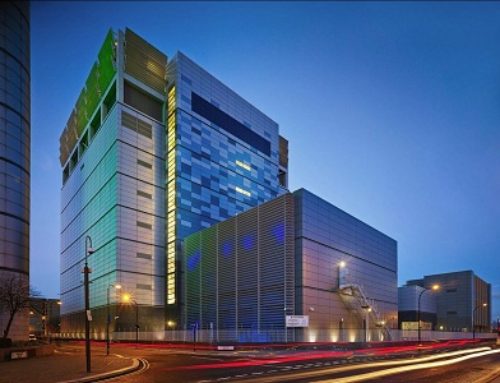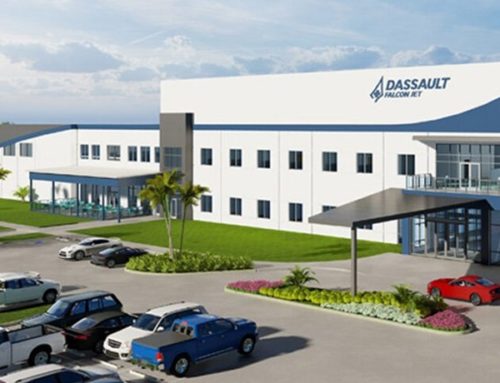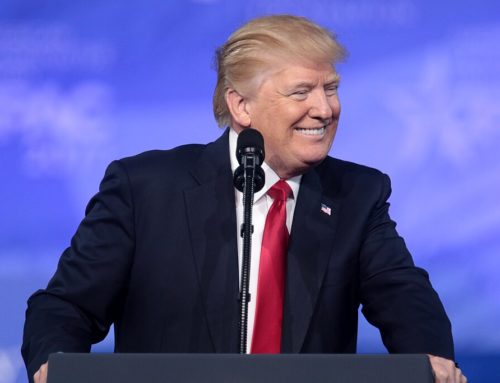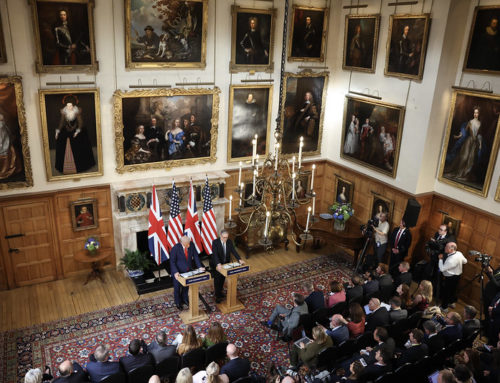1. Schütz Opens $166M Kenosha Plant
German industrial packaging company Schütz Container Systems has officially opened its new $166 million production facility in Kenosha, Wisconsin, marking a major milestone in its North American expansion strategy.
The 370,000-square-foot facility is designed to enhance Schütz’s operational efficiency and sustainability across the Midwest, one of the fastest-growing regions in the U.S. market. The investment is expected to create 185 jobs over the next five years, reinforcing Kenosha’s position as a hub for advanced manufacturing.
“This new facility marks a significant step in expanding our capabilities and strengthening our commitment to the North American market,” said Frederik Wenzel, President and CEO of Schütz Container Systems North America. “With this state-of-the-art production site, we can provide our customers with our renowned quality products and services while continuing to focus on sustainability and reducing our carbon footprint.”
The Kenosha plant complements Schütz’s existing network of 13 U.S. sites, ensuring greater supply chain flexibility and security. Strategically located to serve Midwest markets, the facility benefits from Kenosha’s skilled workforce and logistical advantages, which have already prompted discussions of future expansion.
In alignment with Schütz’s Green Lifecycle Management philosophy, the company plans to expand the site in fall 2025 to include a reconditioning facility for used industrial packaging—an initiative aimed at advancing circular economy practices.
The Wisconsin Economic Development Corporation (WEDC) is supporting the project with up to $1 million in performance-based state tax credits, contingent on job creation and capital investment benchmarks. “Schütz is the kind of innovative manufacturer that belongs in Wisconsin,” said WEDC Secretary and CEO Missy Hughes. “We’re proud to partner with them to ensure their success in our state.”
Kenosha Mayor David Bogdala welcomed the investment, noting, “Schütz is known as a leader in container solutions. The plant will strategically serve Midwest markets while providing quality job opportunities in Kenosha.”
With its commitment to sustainability, innovation, and regional growth, Schütz’s new facility is poised to become a cornerstone of the company’s U.S. operations and a catalyst for economic development in southeastern Wisconsin.
2. Georgia’s Trade Mission to Brazil and Argentina
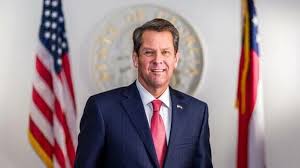
Georgia Governor Brian Kemp is leading a high-profile trade mission to Brazil and Argentina this week, aimed at strengthening economic ties and expanding opportunities for Georgia businesses in South America. The mission, which includes First Lady Marty Kemp, Agriculture Commissioner Tyler Harper, and representatives from the Georgia Department of Economic Development and Georgia Ports Authority, underscores the state’s commitment to global partnerships and economic growth.
The delegation’s itinerary includes meetings with executives from companies already operating in Georgia or planning new investments, as well as diplomatic engagements and bilateral relationship-building sessions. Notably, the trip coincides with the 30th anniversary of Georgia’s trade office in Brazil, a milestone that highlights the state’s long-standing presence and influence in the region.
Governor Kemp emphasised the importance of the mission, stating, “Companies from South America have invested over $160 million in Georgia over the last six years. Businesses operating in Brazil have created over a thousand jobs for Georgians, especially in agriculture—our No. 1 industry.”
The mission also includes a defense component. Major General Richard “Dwayne” Wilson of the Georgia National Guard will meet with Argentinian counterparts as part of the Department of Defense’s State Partnership Program, reinforcing shared security goals.
Georgia’s trade with Brazil and Argentina is substantial. In 2024, exports to Brazil reached $748 million, while exports to Argentina totaled $120 million. These figures reflect the growing importance of South America as a trade partner, particularly in sectors like agribusiness, infrastructure, and food and beverage.
Several South American companies with operations in Georgia are spotlighted during the mission:
- Pilgrim’s: Supporting 9,000 jobs in Georgia, with a $400 million investment in a new facility in LaFayette.
- Taurus: Relocated its U.S. headquarters to Bainbridge, creating over 350 jobs.
- Embraer: Operates a key aircraft maintenance facility in Macon.
- GranBio: Runs a biorefinery and R&D center in Thomaston.
- BERSA: Maintains a production facility in Cartersville.
- AGCO and Guidoni Group: Represent significant investments and connections to Brazil and Argentina.
Commissioner Pat Wilson of the Georgia Department of Economic Development noted, “Brazil and Argentina are home to some of the largest agriculture and infrastructure companies in South America, aligning with Georgia’s strengths and future growth.”
This mission not only celebrates past achievements but also sets the stage for future collaborations that will benefit Georgia’s economy and its citizens.
3. Fluence and ACE open battery plant in Southeast Asia

Fluence Energy and ACE Engineering have officially launched a state-of-the-art, automated manufacturing facility in Bac Giang Province, Vietnam.
The new facility boasts an impressive annual production capacity of 35 gigawatt-hours and is designed to manufacture Fluence’s latest energy storage solutions, including Gridstack Pro™ and Smartstack™. These systems cater to both utility-scale and commercial applications, offering enhanced safety, scalability, and intelligent energy management capabilities.
Julian Nebreda, President and CEO of Fluence, emphasised the significance of the launch:
“This facility builds on our deep strategic relationship with ACE Engineering, taking us to the next level of manufacturing excellence. By combining advanced automation with rigorous quality standards, we believe we are optimally situated to meet stringent customer requirements and deliver competitively at the speed and scale the market demands.”
Danny You, CEO of ACE Engineering, echoed this sentiment, highlighting the partnership’s long-term vision:
“This state-of-the-art facility represents an expanding strategic partnership between Fluence and ACE. With this initiative, we will be positioned to provide customers with flexible manufacturing solutions, shorter lead times, and the highest quality standards.”
The fully automated production process is engineered to enhance both productivity and safety, aligning with Fluence’s broader mission to accelerate the global transition to sustainable energy. The facility is expected to produce enough systems annually to support approximately 8.75 GW of 4-hour duration battery storage, a substantial contribution to global grid resilience.
This expansion comes amid Fluence’s ongoing efforts to diversify its manufacturing footprint. While the company has invested heavily in U.S.-based facilities to qualify for domestic content incentives under the Inflation Reduction Act, delays in scaling those sites prompted a renewed focus on Southeast Asia. The Vietnam facility complements Fluence’s global supply chain strategy and reinforces its presence in the region.
As of mid-2025, Fluence has deployed 6.3 GW / 16.7 GWh of energy storage systems globally, with a contracted backlog of 8.2 GW and a development pipeline exceeding 35 GW / 114 GWh.
The launch of this facility not only strengthens Fluence’s manufacturing capabilities but also signals Southeast Asia’s growing role in the global energy storage ecosystem. With other major players like CATL and REPT Battero investing in the region, Vietnam is poised to become a key hub for battery innovation and production.
4. Trump meets South Korea’s new leader in Washington

President Donald Trump hosted South Korean President Lee Jae Myung at the White House on Monday for a high-stakes bilateral meeting focused on trade, defense, and the evolving geopolitical landscape of the Korean Peninsula.
The summit marked the first in-person engagement between the two leaders since Lee’s election in June, following the dramatic ouster of former President Yoon Suk Yeol, who had briefly imposed martial law in South Korea before being impeached and jailed.
Ahead of the meeting, Trump stirred controversy by posting on Truth Social that South Korea appeared to be undergoing a “Purge or Revolution,” referencing recent raids on the Unification Church and a South Korean-controlled section of Osan Air Base. Despite initial concerns, the tone of the meeting quickly shifted to cooperation.
Trade and Economic Cooperation
Central to the discussions was a July trade agreement that set tariffs on South Korean goods at 15%, down from a previously threatened 25%. Trump praised South Korea’s commitment to invest \$350 billion in U.S.-controlled ventures, including a $150 billion initiative dubbed “Make America Shipbuilding Great Again,” aimed at revitalising the American shipbuilding industry.
President Lee expressed optimism about the economic partnership, noting South Korea’s interest in contributing to the U.S. manufacturing renaissance. He also praised the decor of the Oval Office, calling it “bright and beautiful,” and symbolic of American dignity
Defense and North Korea
Defense cooperation was another key topic, particularly the continued presence of 28,000 U.S. troops in South Korea. Trump hinted at renegotiating terms, including potential U.S. ownership of land hosting military bases.
Both leaders expressed a shared interest in stabilising the Korean Peninsula. Trump announced his intention to meet North Korean leader Kim Jong Un “possibly as early as this year,” a move welcomed by Lee, who emphasised the importance of peace in the region.
Lee remarked, “I hope you would make peace on the Korean Peninsula, which remains the only separated country in the world,” even joking that a Trump Tower in Pyongyang would allow him to “play golf in North Korea.”
5. £432M Italian trade fund to expand India ties

In a strategic move to deepen economic ties with India, the Italian government has unveiled a £432 million export finance initiative titled “Misura India”, aimed at enhancing Italian exports and supporting businesses entering or expanding within the Indian market.
Administered by SIMEST, Italy’s export finance agency, the fund is part of a broader push to engage more robustly with the Global South amid declining demand in traditional Western markets and rising tariff barriers. The initiative was finalised on 31 July 2025 and will officially launch on 15 September, with applications for financing available online.
Key Components of the Fund
£173 million will be allocated to highly subsidised export financing, with interest rates capped at 0.6%. This portion targets Italian firms seeking to enter the Indian market or establish joint ventures.
The remaining £259 million will expand SIMEST’s existing trade finance tools, including guarantees, trade credit insurance, and letters of credit, aimed at helping firms already operating in India to scale up and secure additional working capital.
Strategic Goals and Market Focus
“Misura India” is designed to bolster Italy’s presence in India’s rapidly growing economy, particularly in sectors such as high-end fashion, food, and pharmaceuticals. Italy currently faces a £1.25 billion trade deficit with India but remains one of its largest EU trading partners, with 773 Italian firms already active in the country.
The initiative also reflects Italy’s ambition to diversify its trade relationships and reduce reliance on Western markets, especially in light of recent US tariffs on Indian goods and the UK-India trade deal, which is expected to boost bilateral trade by £4.8 billion.
Broader Implications
While EU member states cannot negotiate independent trade agreements or tariff exemptions, export finance programs like Misura India offer a strategic workaround to enhance bilateral trade and market access. Smaller parallel funds of £7.1 million and £1.3 million have also been announced to support Italian exporters targeting Africa and Latin America, signaling a wider global outreach strategy.
This initiative marks a significant step in Italy’s evolving trade policy, positioning it to leverage India’s growing influence in global commerce and to secure a stronger foothold in emerging markets.

